
Dennis Loren: Jimi Hendrix complemented me for the poster I had done (Part Two)
BANDS : Frank Zappa, Jimi Hendrix, The Jimi Hendrix Experience, The Velvet UndergroundThe lines below are the continuation of an extensive interview featuring Dennis Loren, which had to be split in two fragments. Click here to read the first part.
Metalfan: In the spring of 1967 you returned in the USA and you decided to stay in San Francisco. Such moment is often described by people as something unique. How it was for you?
Dennis Loren: It was wonderful to be in San Francisco during that period of time. How I got there was another stroke of luck. Before I left Turkey, my orders for my next duty station were changed several times. At first I was given orders for a unit in Italy. These orders were again changed to a base in Germany and finally to the Presidio of San Francisco. I was assigned to a small five man unit attached to 6th Army Intelligence at the Presidio for the remaining months before my discharge. I was originally assigned quarters at the Company C barracks, but my Colonel soon gave me what was called a “per diem allowance” and I was able to rent an apartment near the corner of Arguello and Clement streets in the Richmond district of San Francisco. Arguello Street went up the hill and ended at one of the Presidio’s back gates.
During my free time I explored the city of San Francisco. It didn’t take very long to locate a number of art galleries and music venues, because of the many posters that I found hanging all over town and in record shops. The first music club I went to was The Matrix, were I first saw The Doors, The Youngbloods, Quicksilver Messenger Service, Sopwith Camel, The Sons Of Champlin, The Santana Blues Band (as they were called then) and a host of other groups. I quickly fell in to a routine of going to The Matrix on Thursday evening, the Avalon Ballroom on Friday evening and the Fillmore Auditorium or Winterland on Saturday evening. On Sunday afternoon’s many bands would play for free in Golden Gate Park, the Panhandle and other parks around San Francisco, as well as street fairs. I also saw concerts at the Jazz Workshop, The Roaring Twenties, The Coffee Gallery and Coffee & Confusion in North Beach, the Straight Theatre in Haight/Ashbury district and Cedar Alley in the South of Market Street area. In June I went to the Magic Mountain Festival on Mount Tamalpias in Marin County.
Each week I called Kay Jackson and told her what was going on in San Francisco. She made plans to join me in September and transfer her art studies to the San Francisco Insitute of Arts. During the summer, she returned to Dearborn. In June she called me and said that she had gotten me a poster design job for Muddy Waters appearance at The Living End in Detroit. As soon as I finished and mailed her the artwork, I got very busy designing two more posters. I had met poster artist Rick Griffin in Berkeley at The Print Mint. We talked about poster art. I asked him if he knew of a venue that I could design some posters for. He suggested that I start with The Matrix and try to build a portfolio that I could take to Chet Helms at the Avalon and Bill Graham at the Fillmore. The first San Francisco poster I designed was for The Youngbloods concert at The Matrix. While I was hanging this poster on Haight Street, I was approached by a group of Diggers who told me about an upcoming free Jimi Hendrix Experience concert in the Panhandle were The Diggers distributed free food. They asked if I would make a poster for this event.
Metalfan: In the spring of 1967 you returned in the USA and you decided to stay in San Francisco. Such moment is often described by people as something unique. How it was for you?
Dennis Loren: It was wonderful to be in San Francisco during that period of time. How I got there was another stroke of luck. Before I left Turkey, my orders for my next duty station were changed several times. At first I was given orders for a unit in Italy. These orders were again changed to a base in Germany and finally to the Presidio of San Francisco. I was assigned to a small five man unit attached to 6th Army Intelligence at the Presidio for the remaining months before my discharge. I was originally assigned quarters at the Company C barracks, but my Colonel soon gave me what was called a “per diem allowance” and I was able to rent an apartment near the corner of Arguello and Clement streets in the Richmond district of San Francisco. Arguello Street went up the hill and ended at one of the Presidio’s back gates.
During my free time I explored the city of San Francisco. It didn’t take very long to locate a number of art galleries and music venues, because of the many posters that I found hanging all over town and in record shops. The first music club I went to was The Matrix, were I first saw The Doors, The Youngbloods, Quicksilver Messenger Service, Sopwith Camel, The Sons Of Champlin, The Santana Blues Band (as they were called then) and a host of other groups. I quickly fell in to a routine of going to The Matrix on Thursday evening, the Avalon Ballroom on Friday evening and the Fillmore Auditorium or Winterland on Saturday evening. On Sunday afternoon’s many bands would play for free in Golden Gate Park, the Panhandle and other parks around San Francisco, as well as street fairs. I also saw concerts at the Jazz Workshop, The Roaring Twenties, The Coffee Gallery and Coffee & Confusion in North Beach, the Straight Theatre in Haight/Ashbury district and Cedar Alley in the South of Market Street area. In June I went to the Magic Mountain Festival on Mount Tamalpias in Marin County.
Each week I called Kay Jackson and told her what was going on in San Francisco. She made plans to join me in September and transfer her art studies to the San Francisco Insitute of Arts. During the summer, she returned to Dearborn. In June she called me and said that she had gotten me a poster design job for Muddy Waters appearance at The Living End in Detroit. As soon as I finished and mailed her the artwork, I got very busy designing two more posters. I had met poster artist Rick Griffin in Berkeley at The Print Mint. We talked about poster art. I asked him if he knew of a venue that I could design some posters for. He suggested that I start with The Matrix and try to build a portfolio that I could take to Chet Helms at the Avalon and Bill Graham at the Fillmore. The first San Francisco poster I designed was for The Youngbloods concert at The Matrix. While I was hanging this poster on Haight Street, I was approached by a group of Diggers who told me about an upcoming free Jimi Hendrix Experience concert in the Panhandle were The Diggers distributed free food. They asked if I would make a poster for this event.
Loren’s first three concert posters for Muddy Waters at the Living End in Detroit (left),
The Youngbloods at The Matrix in San Francisco (centre)
and The Jimi Hendrix Experience at the Panhandle of Golden Gate Park in the Haight-Ashbury district.
The Youngbloods at The Matrix in San Francisco (centre)
and The Jimi Hendrix Experience at the Panhandle of Golden Gate Park in the Haight-Ashbury district.
In mid-August I received a call from Dave Halstead. He told me that Kay Jackson had been killed in an automobile accident. I was devastated by this news, because Kay and I had made so many plans together. I somehow got through this time of mourning by dedicating my future to art and music in Kay’s memory.
Several days later I met guitarist Joe Toschi and bass player/singer Bobby Scadari at The Matrix. They had both been a group called The Hyde Street Cable Car that had broken up. I invited them to Presidio Service Club to jam with some other soldier musicians that I knew. The three of us formed a new group with guitarist David Green, percussionist/singer Bruce Hanson and drummer Rich Butler. I played the autoharp, the harmonica and was the lead singer. We called this band The New Gothic Blues Unit. Our first gigs were playing for dances at the Presidio Service Club. We rehearsed in one of the service club’s upstairs rooms. After a number of shows, Bobby decided to relocate to San Diego. Bruce was killed in a motorcycle accident. Rich who was riding with him lived but was never quite the same and often deeply depressed. We continued on for a while and changed the name of the group to Mercury Vapor. Months later David was sent to Japan. During this period of time, I met Elsie Vollmer who attended many of our performances and we were soon got married. Joe and I continued on as an acoustic duo called Patchwork. We performed at The Coffee Gallery, Coffee & Confusion and Cedar Alley.
Several days later I met guitarist Joe Toschi and bass player/singer Bobby Scadari at The Matrix. They had both been a group called The Hyde Street Cable Car that had broken up. I invited them to Presidio Service Club to jam with some other soldier musicians that I knew. The three of us formed a new group with guitarist David Green, percussionist/singer Bruce Hanson and drummer Rich Butler. I played the autoharp, the harmonica and was the lead singer. We called this band The New Gothic Blues Unit. Our first gigs were playing for dances at the Presidio Service Club. We rehearsed in one of the service club’s upstairs rooms. After a number of shows, Bobby decided to relocate to San Diego. Bruce was killed in a motorcycle accident. Rich who was riding with him lived but was never quite the same and often deeply depressed. We continued on for a while and changed the name of the group to Mercury Vapor. Months later David was sent to Japan. During this period of time, I met Elsie Vollmer who attended many of our performances and we were soon got married. Joe and I continued on as an acoustic duo called Patchwork. We performed at The Coffee Gallery, Coffee & Confusion and Cedar Alley.
Left: A photo of PART Two taken just after the opening performance for a basketball game in Sinop, Turkey,
when they were announcing the players; left to right are Dennis Loren, guitarist Mike Kuric, drummer Bill Banta
and guitarist Tom Sellew; right: a photo of MERCURY VAPOR during one of the performances
at the Presidio Service Club; left to right are guitarist Joe Toschi, drummer Rich Butler, Loren and guitarist David Green.
when they were announcing the players; left to right are Dennis Loren, guitarist Mike Kuric, drummer Bill Banta
and guitarist Tom Sellew; right: a photo of MERCURY VAPOR during one of the performances
at the Presidio Service Club; left to right are guitarist Joe Toschi, drummer Rich Butler, Loren and guitarist David Green.
Eventually Joe and I found drummer Jim Reynolds and bass player Marty DeClerq and we continued on as Mercury Vapor. After my discharge I took a job with a company called Graphic Reproductions. My job was restore blueprints, retouch film negatives and prepare plates for printing. I had decided to stay in San Francisco because of the vibrant art and music scene.
Metalfan: I have to say that 1967 was like a sonic explosion with so many bands that made a huge impact with their work. The Doors released their self-titled album, The Velvet Underground & Nico put out their iconic debut, and Jefferson Airplane released their second record, “Surrealistic Pillow”, which it is now often regarded as the soundtrack of the social phenomenon “Summer of Love”. When it comes to the music how was that time for you?
Dennis Loren: I was so very glad to be in San Francisco during this time. The music scene was very important to me. I met many wonderful musicians and visual artists. I heard all of the San Francisco bands – Jefferson Airplane, The Charlatans, Country Joe & The Fish, Big Brother & The Holding Company, Quicksilver Messenger Service, Moby Grape, The Grateful Dead, It’s A Beautiful Day, Blue Cheer, The Steve Miller Band, The Flamin’ Groovies, Mad River, Mother Earth and others – at the concerts that I attended. These bands performed with visiting acts, such as the Butterfield Blues Band, The Byrds, Cream, Buffalo Springfield, B.B. King, the Jimi Hendrix Experience, The Doors, Miles Davis, John Mayall’s Bluesbreakers, Pink Floyd, Procol Harum, H.P. Lovecraft, Traffic, The Soft Machine, Spirit, Jethro Tull, The MC5, Fairport Convention, The Incredible String Band, The Jeff Beck Group, Led Zeppelin and so many others that it is hard to name them all. All you have to do is look at the posters of this era to see what an eclectic mix of talent was presented by Chet Helms and Bill Graham and the others promoters. Normally, there would be three bands and these shows would only cost $3.00 dollars to attend. It is hard to describe these concerts, but so many of them still stand out in my memory.
Metalfan: I have to say that 1967 was like a sonic explosion with so many bands that made a huge impact with their work. The Doors released their self-titled album, The Velvet Underground & Nico put out their iconic debut, and Jefferson Airplane released their second record, “Surrealistic Pillow”, which it is now often regarded as the soundtrack of the social phenomenon “Summer of Love”. When it comes to the music how was that time for you?
Dennis Loren: I was so very glad to be in San Francisco during this time. The music scene was very important to me. I met many wonderful musicians and visual artists. I heard all of the San Francisco bands – Jefferson Airplane, The Charlatans, Country Joe & The Fish, Big Brother & The Holding Company, Quicksilver Messenger Service, Moby Grape, The Grateful Dead, It’s A Beautiful Day, Blue Cheer, The Steve Miller Band, The Flamin’ Groovies, Mad River, Mother Earth and others – at the concerts that I attended. These bands performed with visiting acts, such as the Butterfield Blues Band, The Byrds, Cream, Buffalo Springfield, B.B. King, the Jimi Hendrix Experience, The Doors, Miles Davis, John Mayall’s Bluesbreakers, Pink Floyd, Procol Harum, H.P. Lovecraft, Traffic, The Soft Machine, Spirit, Jethro Tull, The MC5, Fairport Convention, The Incredible String Band, The Jeff Beck Group, Led Zeppelin and so many others that it is hard to name them all. All you have to do is look at the posters of this era to see what an eclectic mix of talent was presented by Chet Helms and Bill Graham and the others promoters. Normally, there would be three bands and these shows would only cost $3.00 dollars to attend. It is hard to describe these concerts, but so many of them still stand out in my memory.
Photos took by Loren at the Fillmore West and The Family Dog venues using black and white Tri-X film
with a flash attachment, so you don’t see the light show in the background;
left: Ian Anderson of Jethro Tull; centre: The MC5; right: Marc Bolan of Tyrannosaurus Rex.
with a flash attachment, so you don’t see the light show in the background;
left: Ian Anderson of Jethro Tull; centre: The MC5; right: Marc Bolan of Tyrannosaurus Rex.
These concerts were happenings that included light shows and of course the posters used to advertise these events. I have mentioned many of the artists earlier in this interview, but I should now mention the light shows. Bill Ham was one of the first people to begin experimenting with what he described as “painting with light.” He had come to San Francisco during the 1950s and worked with jazz musicians. Bill would improvise using his projected lighting techniques while the musicians improvised with their music. Bill developed a box with pulsating coloured lights that responded to the music for The Charlatans during their summer residency at the Red Dog Saloon in 1965. The group’s autoharp player George Hunter and piano player Mike Ferguson were also artists and collaborated on a poster that became known as “The Seed” by poster collectors. Many friends of The Charlatans attended these shows. Among them were Alton Kelley, Ellen Harmon, Luria Castille and Jack Tolle who formed The Family Dog, a production company to present what they called dance/concerts.
During the fall of 1965, The Family Dog presented their first dance/concerts at Longshoreman’s Hall in San Francisco. Alton Kelley designed many of these early posters. By 1966 Chet Helms took charge and booked The Family Dog dance/concerts at the Fillmore Auditorium. Chet initially alternated weekends with Bill Graham, but soon moved to the Avalon Ballroom when Bill signed a lease with the Fillmore building owners. Chet hired Wes Wilson to design and print posters beginning with the first Family Dog Fillmore concert with Jefferson Airplane. During these early Family Dog concerts, Bill Ham was asked to provide the lights. He used a series of overhead projectors that would cast the pulsing coloured amoeba like shapes onto the white screens behind the bands. Bill also added slides and film clips into the mix of images that he projected. Soon Bill Graham decided to add light shows to his Fillmore concerts. Eventually there were almost as many different light show groups in San Francisco as there were bands. They used clever names like The Deadly Nightshade, The Holy See, the Ibis Alchemical Company, Jerry Abram’s Headlights, Electro Luminescence and Single Wing Turquoise Bird. Ironically, I never saw The Velvet Underground with Nico, but I would eventually design a poster for the four piece version of the group when they played with the Chicago Transit Authority in 1968 at the Whisky A Go-Go in Los Angeles.
Left: The concert poster for The Velvet Underground at the Whisky A Go-Go in West Hollywood, California in October 1968;
centre: The Steve Miller Band at Ford Auditorium in Detroit, Michigan in 1972;
right: The Rockets at the Motor City Showcase (the old Eastown Theatre) in Detroit in 1975;
Gary Grimshaw designed The Rockets logo used by Loren.
centre: The Steve Miller Band at Ford Auditorium in Detroit, Michigan in 1972;
right: The Rockets at the Motor City Showcase (the old Eastown Theatre) in Detroit in 1975;
Gary Grimshaw designed The Rockets logo used by Loren.
Metalfan: That time was a period when people started to gain more of the rights. There was a revolution of mind that happened with the help of art. Now, do you believe that things like that could happen again?
Dennis Loren: I think it could be possible, but it was a very different time. Many things that the young people of the 1960s got involved in did bring about positive changes that are still being felt today. The lyrics of songs often had a political message of protest or liberation. Yet the same “type” of authoritarian people that wanted to silence these voices then, seem to be in power today. During the 1970s we began to see some things change for the better, while other things became more tightly controlled. This may seem trivial compared to other things on a consciousness, spiritual or political level, but as an example, I began to see the music industry change and not for the better.
FM radio stations that had once had “freeform” music formats became “album oriented rock” stations with much tighter play lists that catered to famous bands and the major record labels. In fact, radio stations today are so niche marketed that they only appeal to a certain audience and are not as eclectic as they once were. When I think back to my teen years AM radio stations would play all kinds of music across a wide variety of styles. Now they are mostly “talk” or “news” programs. Prior to 1966 FM stations mostly played Classical or jazz music or had religious programing. My late friend Larry Miller (another person from Detroit) started the first “freeform” music program on FM radio station KMPX in San Francisco. He would later help start WABX FM in Detroit.
Concerts too began to be held in large stadiums and the smaller venues closed their doors. This may have been okay if you were a major band with a lot of record company support, but it strangled a local scene where up and coming bands could not find a place to play. This forced many of these young groups to perform in bars and pubs that severed alcohol and where they were made to play cover songs of popular hits by other popular bands.
Hard drugs also had a terrible effect and led some into a darker lifestyle and even death. Not unlike the opioid crisis we have in America today. I am glad that many states in this country have seen the benefits of medical marijuana and passed laws in favour of this. Most venues today serve alcohol. I didn’t see this in the ‘60s. And yet smokers of tobacco are not allowed to smoke in these same venues. During the ‘60s the music was an integral part of the Cultural Revolution and not just considered entertainment. This is something that I don’t think is happening today. Although I sometimes do see new bands that spring up in some locations that have a similar camaraderie. The most important about what happened in San Francisco, Detroit and other places during the ‘60s was sense of belonging to a scene that was held together by music, art and helping each other and NOT a sense of competition. If the same kind of Cultural Revolution was to happen today it would need a similar feeling and need for change. People today may be more complacent, but we can always hope – ha!!!
Metalfan: So, it was in the '60s when you've formed the band Mercury Vapor. How would you describe the musical style of the band? Did you get the chance to record any music under this name?
Dennis Loren: While we were still called The New Gothic Blues Unit we played a mixture of original songs I had written, along with our own arrangements of older blues, folk and popular rock songs. English groups such as The Beatles, The Zombies, The Yardbirds, The Pretty Things, Them, The Animals, The Rolling Stones, as well as American bands like The Byrds, The Lovin’ Spoonful, Love and the Paul Butterfield Blues Band were all a big influence to varying degrees on the various members of the band. So was the music of Bob Dylan, Howlin’ Wolf, Mose Allison, Willie Dixon and B.B. King. We did an extended versions of songs, such as “Hey Joe,” “Seventh Son,” “Smokestack Lightning” and even our own version of The Beatles song “Eleanor Rigby” – ha!!! By the time we evolved into Mercury Vapor we began to concentrate more on original material.
Our friend John Rosenstock – who went by the name “Storm Light” – had his own band called Steel Wool. John also worked for Santana and It’s A Beautiful Day as a road manager/roadie. He arranged for Mercury Vapor to use It’s A Beautiful Day’s rehearsal space. It was in this space that we made some demo recordings. I am not certain who has those recordings now. I wish I could track them down – ha!!! Later, John opened a large rehearsal studio complex called Mushroom Studios near Ocean Beach and the old Playland Amusement Park. Mercury Vapor shared one of the spaces with Steel Wool.
After David Green returned from Japan, he re-joined the band, but we gradually went our separate ways. We had no disagreements over the music we were playing, it just became more difficult to get all five members in one place at the same time. There seemed to be so many outside distractions hindering the focus that was required to keep the group going. In recent years, I did spend some time with Joe Toschi and we talked of making some new recordings of our old material, but unfortunately he passed away before that could happen. Life can take a group of friends in so many different directions. At some point, I realized that I should concentrate on my artwork, although I did continue into the late ‘70s as a solo singer-songwriter that performed some of those songs. I recorded “Let Go” on the compilation album “Stone Soup” in 1976.
Metalfan: In February 1970 you got the chance to play harmonica with B.B. King at The Fillmore West. That is a story that I would love to hear. Was it for the whole concert or just for a couple of songs?
Dennis Loren: I think it could be possible, but it was a very different time. Many things that the young people of the 1960s got involved in did bring about positive changes that are still being felt today. The lyrics of songs often had a political message of protest or liberation. Yet the same “type” of authoritarian people that wanted to silence these voices then, seem to be in power today. During the 1970s we began to see some things change for the better, while other things became more tightly controlled. This may seem trivial compared to other things on a consciousness, spiritual or political level, but as an example, I began to see the music industry change and not for the better.
FM radio stations that had once had “freeform” music formats became “album oriented rock” stations with much tighter play lists that catered to famous bands and the major record labels. In fact, radio stations today are so niche marketed that they only appeal to a certain audience and are not as eclectic as they once were. When I think back to my teen years AM radio stations would play all kinds of music across a wide variety of styles. Now they are mostly “talk” or “news” programs. Prior to 1966 FM stations mostly played Classical or jazz music or had religious programing. My late friend Larry Miller (another person from Detroit) started the first “freeform” music program on FM radio station KMPX in San Francisco. He would later help start WABX FM in Detroit.
Concerts too began to be held in large stadiums and the smaller venues closed their doors. This may have been okay if you were a major band with a lot of record company support, but it strangled a local scene where up and coming bands could not find a place to play. This forced many of these young groups to perform in bars and pubs that severed alcohol and where they were made to play cover songs of popular hits by other popular bands.
Hard drugs also had a terrible effect and led some into a darker lifestyle and even death. Not unlike the opioid crisis we have in America today. I am glad that many states in this country have seen the benefits of medical marijuana and passed laws in favour of this. Most venues today serve alcohol. I didn’t see this in the ‘60s. And yet smokers of tobacco are not allowed to smoke in these same venues. During the ‘60s the music was an integral part of the Cultural Revolution and not just considered entertainment. This is something that I don’t think is happening today. Although I sometimes do see new bands that spring up in some locations that have a similar camaraderie. The most important about what happened in San Francisco, Detroit and other places during the ‘60s was sense of belonging to a scene that was held together by music, art and helping each other and NOT a sense of competition. If the same kind of Cultural Revolution was to happen today it would need a similar feeling and need for change. People today may be more complacent, but we can always hope – ha!!!
Metalfan: So, it was in the '60s when you've formed the band Mercury Vapor. How would you describe the musical style of the band? Did you get the chance to record any music under this name?
Dennis Loren: While we were still called The New Gothic Blues Unit we played a mixture of original songs I had written, along with our own arrangements of older blues, folk and popular rock songs. English groups such as The Beatles, The Zombies, The Yardbirds, The Pretty Things, Them, The Animals, The Rolling Stones, as well as American bands like The Byrds, The Lovin’ Spoonful, Love and the Paul Butterfield Blues Band were all a big influence to varying degrees on the various members of the band. So was the music of Bob Dylan, Howlin’ Wolf, Mose Allison, Willie Dixon and B.B. King. We did an extended versions of songs, such as “Hey Joe,” “Seventh Son,” “Smokestack Lightning” and even our own version of The Beatles song “Eleanor Rigby” – ha!!! By the time we evolved into Mercury Vapor we began to concentrate more on original material.
Our friend John Rosenstock – who went by the name “Storm Light” – had his own band called Steel Wool. John also worked for Santana and It’s A Beautiful Day as a road manager/roadie. He arranged for Mercury Vapor to use It’s A Beautiful Day’s rehearsal space. It was in this space that we made some demo recordings. I am not certain who has those recordings now. I wish I could track them down – ha!!! Later, John opened a large rehearsal studio complex called Mushroom Studios near Ocean Beach and the old Playland Amusement Park. Mercury Vapor shared one of the spaces with Steel Wool.
After David Green returned from Japan, he re-joined the band, but we gradually went our separate ways. We had no disagreements over the music we were playing, it just became more difficult to get all five members in one place at the same time. There seemed to be so many outside distractions hindering the focus that was required to keep the group going. In recent years, I did spend some time with Joe Toschi and we talked of making some new recordings of our old material, but unfortunately he passed away before that could happen. Life can take a group of friends in so many different directions. At some point, I realized that I should concentrate on my artwork, although I did continue into the late ‘70s as a solo singer-songwriter that performed some of those songs. I recorded “Let Go” on the compilation album “Stone Soup” in 1976.
Metalfan: In February 1970 you got the chance to play harmonica with B.B. King at The Fillmore West. That is a story that I would love to hear. Was it for the whole concert or just for a couple of songs?
Picture taken by Dennis Loren’s friend Frank Pettis of Dennis and B.B. King backstage
at the Masonic Auditorium in Detroit in 1985; Dennis holds the poster that he designed for B.B.’s concert
at the same venue in 1975 and Mr. King is holding a copy of R.P.M. (Record Profile Magazine)
that featured his friend Howlin’ Wolf on the cover.
at the Masonic Auditorium in Detroit in 1985; Dennis holds the poster that he designed for B.B.’s concert
at the same venue in 1975 and Mr. King is holding a copy of R.P.M. (Record Profile Magazine)
that featured his friend Howlin’ Wolf on the cover.
Dennis Loren: Actually just one song, ha!!! What happened was this. There was a bulletin board at Mushroom Studios and one day I happened to see a posting that B.B. King wanted to jam with some of the younger San Francisco musicians at the Fillmore West during one of his sets. David Green was a huge B.B. King fan. I told him here is your chance to play with B.B. On the evening of the concert we all went down to the Fillmore West. When the time came, B.B. King asked musicians that wanted to play to line-up on both sides of the stage. David began to shake and didn’t move. This kind of made me upset, because he had been so excited about this opportunity prior to the show. It was all he could talk about. I guess David got a severe case of “stage fright.”
I happened to have several harmonicas in my pocket, so in a flash, I decided to go up to the stage and get in line. I happened to stand behind harmonica player Charlie Musslewhite. Guitarist Elvin Bishop played a song with B.B. and then Charlie did. When Charlie returned he said to me something like “Go for it, kid.” I walked out and stood behind the mic he had used and B.B. started playing a blues shuffle.
Thankfully one of the harmonicas I had was in the correct key. I began vamping along with the rhythm section, but I really couldn’t hear myself at first. Finally I could hear myself in a stage monitor, just as B.B. smiled in my direction and nodded his head for me to take a solo. On the last note of my solo B.B. came in and played the same note on his guitar and went into his own solo. As I returned to the audience people kept patting me on the back, so I must have done okay – ha!!! David, Joe, Marty, Jim and our other friends were all stunned that I had done this, but I still could convince David to go up and play.
In 1975, I designed a poster for B.B. King’s concert at Detroit’s Masonic Auditorium and in 1985, I would interview him at the same venue. His drummer Sonny Freeman was there and said that he remembered me. I didn’t think that was possible, but he said that I was the only red haired person with glasses that had every played harmonica with them. B.B. just laughed as said, “Sonny we are still out on the road, while this young man has a good job with a music magazine.” We all laughed. B.B. was a very kind and humble man.
Metalfan: In 1969, B.B. King have released the album "Completely Well" which also featured the song "The Thrill Is Gone," which become a major hit for Mr. King. Do you remember the first time you got the chance to listen to "Completely Well" album?
Dennis Loren: David Green and I went to many of B.B. King’s concerts at the Fillmore. The first one that I attended, B.B. was very moved that so many young white people had come to hear him play. I am certain that I heard him play the song “The Thrill Is Gone,” in several of his concerts before he had recorded it on the album you mention. That was one of the great things about seeing live music in those days. That is one of those great songs that a person remembers. Metalfan: You’ve created concert posters, LP and CD packaging, print ads and tour merchandise for various big artists such as Frank Zappa, Otis Redding, Muddy Waters, The Jimi Hendrix Experience, Bob Dylan and The Velvet Underground, to name just a few. I think that it would be great if you could share more of the stories about your work with these musicians with us. Dennis Loren: In San Francisco, I became good friends with light show pioneer Bill Ham, Family Dog concert promoter Chet Helms and members of groups such as The Charlatans, Big Brother & The Holding Company, Moby Grape, The Great Society, The Sopwith Camel, Jefferson Starship, The Steve Miller Band, The Flamin’ Groovies, The Sons Of Champlin, Moonalice and many other San Francisco bands.
I happened to have several harmonicas in my pocket, so in a flash, I decided to go up to the stage and get in line. I happened to stand behind harmonica player Charlie Musslewhite. Guitarist Elvin Bishop played a song with B.B. and then Charlie did. When Charlie returned he said to me something like “Go for it, kid.” I walked out and stood behind the mic he had used and B.B. started playing a blues shuffle.
Thankfully one of the harmonicas I had was in the correct key. I began vamping along with the rhythm section, but I really couldn’t hear myself at first. Finally I could hear myself in a stage monitor, just as B.B. smiled in my direction and nodded his head for me to take a solo. On the last note of my solo B.B. came in and played the same note on his guitar and went into his own solo. As I returned to the audience people kept patting me on the back, so I must have done okay – ha!!! David, Joe, Marty, Jim and our other friends were all stunned that I had done this, but I still could convince David to go up and play.
In 1975, I designed a poster for B.B. King’s concert at Detroit’s Masonic Auditorium and in 1985, I would interview him at the same venue. His drummer Sonny Freeman was there and said that he remembered me. I didn’t think that was possible, but he said that I was the only red haired person with glasses that had every played harmonica with them. B.B. just laughed as said, “Sonny we are still out on the road, while this young man has a good job with a music magazine.” We all laughed. B.B. was a very kind and humble man.
Metalfan: In 1969, B.B. King have released the album "Completely Well" which also featured the song "The Thrill Is Gone," which become a major hit for Mr. King. Do you remember the first time you got the chance to listen to "Completely Well" album?
Dennis Loren: David Green and I went to many of B.B. King’s concerts at the Fillmore. The first one that I attended, B.B. was very moved that so many young white people had come to hear him play. I am certain that I heard him play the song “The Thrill Is Gone,” in several of his concerts before he had recorded it on the album you mention. That was one of the great things about seeing live music in those days. That is one of those great songs that a person remembers. Metalfan: You’ve created concert posters, LP and CD packaging, print ads and tour merchandise for various big artists such as Frank Zappa, Otis Redding, Muddy Waters, The Jimi Hendrix Experience, Bob Dylan and The Velvet Underground, to name just a few. I think that it would be great if you could share more of the stories about your work with these musicians with us. Dennis Loren: In San Francisco, I became good friends with light show pioneer Bill Ham, Family Dog concert promoter Chet Helms and members of groups such as The Charlatans, Big Brother & The Holding Company, Moby Grape, The Great Society, The Sopwith Camel, Jefferson Starship, The Steve Miller Band, The Flamin’ Groovies, The Sons Of Champlin, Moonalice and many other San Francisco bands.
Left: A photo taken by Stefanie Herzer she called it “The Smiling”;
From left to right are San Francisco Oracle editor Alan Cohen, Family Dog poster printer Bruce Dauser,
Family Dog concert promoter Chet Helms and Dennis Loren;
the picture was taken at one of Chet’s birthday party at the Great American Music Hall in San Francisco;
right: Kent Wood took this photo of Elvis Costello and Loren in the backstage at the same venue.
From left to right are San Francisco Oracle editor Alan Cohen, Family Dog poster printer Bruce Dauser,
Family Dog concert promoter Chet Helms and Dennis Loren;
the picture was taken at one of Chet’s birthday party at the Great American Music Hall in San Francisco;
right: Kent Wood took this photo of Elvis Costello and Loren in the backstage at the same venue.
The funny thing is when an artist does work for a record company or concert venue, they may not ever meet the bands or solo artist they have done work for. On some occasions I have received a backstage pass and did get to meet them. In the case of Otis Redding, he had already passed away by the time the record company hired me to design the cover for one of his live albums. I have met other musicians in more informal settings, like restaurants and parties. I did meet Jimi Hendrix after he played in the Panhandle and he was a very nice person who complemented me for the poster I had done for this show.
Left: Kent Wood took this photo of Dennis and friends – guitarist Sam Andrew and drummer Dave Getz –
of Big Brother & The Holding Company at the Avalon Ballroom in San Francisco;
right: another picture by Wood of Brian Wilson and Dennis, backstage at Davies Symphony Hall in San Francisco;
Dennis holds the program for the “Smile” tour that he and Mark London designed for Brian and his band.
of Big Brother & The Holding Company at the Avalon Ballroom in San Francisco;
right: another picture by Wood of Brian Wilson and Dennis, backstage at Davies Symphony Hall in San Francisco;
Dennis holds the program for the “Smile” tour that he and Mark London designed for Brian and his band.
When I lived in Hollywood, I became good friends with the band Sweetwater and even went on tour with them as their merchandise person. I have been to rehearsals with Brian Wilson and his band. I even happened to be at Brian’s house when he played the final mix for his “Smile” album for Mark London, his wife Melinda and I. When I did a series of posters for the Whisky A Go-Go’s 35th Anniversary, the English singer/guitarist Terry Reid was happy to see me and gave me a big hug. A few years earlier he and his band had been part of a concert at the House Of Blues in West Hollywood with Spirit, Moby Grape, Big Brother & The Holding Company and Jackie Lomax. Terry told me that he loved the House Of Blues concert poster and sent copies to his family in England. After that show I had pizza with Terry Reid and Jackie Lomax at the Rainbow Bar & Grill. This was a restaurant on the Sunset Strip that was always full of musicians. It was a favourite place for them to gather and socialize. The Frank Zappa album called “Cucamonga” was also a posthumous release, but I did meet his wife and children. I was invited by them to attended Moon Unit’s comedy act at the Moondog Café on Melrose Street in Hollywood. I first met The White Stripes before they were famous when they played at the Crocodile Café in Seattle. I have had the good fortune to meet Bob Dylan, Roger McQuinn and Gene Clark of The Byrds, Richard Manuel and Rick Danko of The Band, Michele Phillips of The Mamas & The Papas, Elvis Costello, Nick Lowe, Johnny “Guitar” Watson, members of Iron Butterfly, Vassar Clements, members of Spirit, Taj Mahal, members of Badfinger, Al Green, Heart, members of the Wrecking Crew (LA studio musicians), members of Poco, members of the New York Dolls, Barry White and so many other musicians. I feel very fortunate that I had the opportunity to meet so many of these great artists.
Left: New York Dolls bass player Arthur Kane (centre) guitarist Sylvain Sylvain and Loren in Hollywood, California;
right: Loren and his business partner Kent Wood backstage at the Warfield Music Theatre in San Francisco
with Meg & Jack White of The White Stripes.
right: Loren and his business partner Kent Wood backstage at the Warfield Music Theatre in San Francisco
with Meg & Jack White of The White Stripes.
I do have one interesting story to relate about meeting two unlikely rock stars... When Creem magazine moved to Hollywood, California I was part of the staff. Publisher Arnold Levitt wanted to make a big publicity “splash” with the music industry in “tinsel town.” He organized a dinner and party in a prestigious hotel ballroom on Sunset Boulevard. Lots of interesting music people and other celebrities were invited. From his old boss Stan Lee (from Marvel Comics) to the heads of record labels like Rhino Records and a diverse number bands, such as The Bangles and Suicidal Tendencies, that were very popular at the time. Creem’s co-editor John Kordosh and I were seated at a dinner table with Little Richard and Ozzy Osborne, of all people. Ozzy was a bit drunk, but he hung on every word that came out of Little Richard’s mouth – ha!!! This was truly an interesting meeting of two rock stars from two different eras that I got to witness. Ozzy just loved listening to all of the stories that Little Richard told us. I wish someone had taken a photo of Little Richard and Ozzy having dinner with John and I.
Left: Loren hanging out backstage with Rick Danko and Richard Manuel of The Band at Gerde’s Folk City
in New York City; right: master bluegrass fiddle player Vassar Clements and Loren
holding the album cover designed by the latter; both photographs taken by Frank Pettis.
in New York City; right: master bluegrass fiddle player Vassar Clements and Loren
holding the album cover designed by the latter; both photographs taken by Frank Pettis.
George Hunter and Michael Wilhelm of The Charlatans asked me to design a poster for the group’s 50th Anniversary of first playing at the Red Dog Saloon in 1965. This was quite an honour for me. I based the poster design on the original 1965 George Hunter & Michael Ferguson poster artwork.
Left: George Hunter and Michael Ferguson’s poster design for their band The Charlatans’ Red Dog Saloon
residency in June 1965; centre: the 2015 poster design for The Charlatans’ 50th Anniversary concert events
held at the Red Dog Saloon and Piper’s Oprea House in Virginia City, Nevada, by Dennis Loren;
right: the three posters – designed by Loren in 2015 as well – that were included in the Quicksilver Messenger Service,
Hot Tuna and Jefferson Airplane limited edition CD box sets.
residency in June 1965; centre: the 2015 poster design for The Charlatans’ 50th Anniversary concert events
held at the Red Dog Saloon and Piper’s Oprea House in Virginia City, Nevada, by Dennis Loren;
right: the three posters – designed by Loren in 2015 as well – that were included in the Quicksilver Messenger Service,
Hot Tuna and Jefferson Airplane limited edition CD box sets.
Last year, I was called personally to design CD packages for Moby Grape member Peter Lewis’ solo album “Just Like Jack”, Greg Douglass’ “Flight Of The Golden Dragon” album and Darby Slick’s “A Songwriter’s Sketchbook” album. Greg was a guitarist with The Steve Miller Band during the ‘70s and of course Darby Slick was the lead guitarist of The Great Society with his brother Jerry on drums and sister-in-law Grace Slick on vocals a various instruments. When Grace joined Jefferson Airplane, they recorded Darby’s song “Somebody To Love.” This song was one of the great anthems of the “Summer Of Love.” I was also asked to design commemorative posters for three limited edition CD box sets released by the Culture Factory USA label, for Jefferson Airplane, Quicksilver Messenger Service and Hot Tuna. 2017 has also kept me busy designing posters for reformed ‘60s band The Seeds and Moonalice.
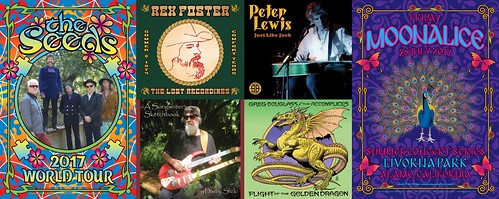
Left: The Seeds 2017 World Tour poster; centre: a few of the recent CD package designs by Dennis Loren,
for Rex Foster, Peter Lewis, Darby Slick and Greg Douglass; right: a recent Moonalice poster for their concert
which took place in Livorna Park in Alamo, California.
Metalfan: In July 1970, you've returned to Detroit where you continued doing art, graphic design and music. Why did you decide to leave San Francisco?
Dennis Loren: My marriage had ended and I got custody of my son Benjamin (who was born in October of 1968). I thought it would be best for us to be around family. Detroit was another music capitol were I had many friends and contacts, so that I could continue my work. All of the music magazines I worked for began in Detroit. Between Goldmine and Creem, I worked for the Westbound Record label. I would also continue to do record packaging and concert posters for The (Motor City) Mutants, Destroy All Monsters, Sonic’s Rendezvous Band, Patti Smith, The Romantics, The Reruns, Cinecyde, The Sillies, Coldcock, Cactus, The Rockets, Ted Lucas & The Spike-Drivers, The Ivories and so many other Detroit new wave era bands. I also performed as a solo singer-songwriter in coffeehouses and colleges. Although my son Ben was born in San Francisco, he thinks of himself as a Detroit person – ha!!! In recent years we have had several reunions with Ben’s mother and my ex-wife Elsie. We are all great friends today, even though we are spread around the country. Ben and his wife Cyndie live near Seattle where he is a computer programmer and Cyndie works for a non-profit foundation. They are a very socially conscious young couple and I am very proud of them. Elsie lives in Florida were she is a nurse at a children’s hospital. In July of 2014, I relocated from the San Francisco Bay area to Dearborn, Michigan – which is 10 miles west of Detroit – to care for my late parent’s home. At 71 years of age, I think my gypsy days are over – ha!!

Two pictures of Ben as a child on the left and centre; on the right of this composite is a photo took by Loren
of Ben and Cyndie in Berkeley, California at the Tibetan Festival in early 2014.
Ironically, because of the internet I have been able to continue to work for clients in San Francisco, Los Angeles, Austin, Texas, New York City, London, Paris and other cities. I have been fortunate to have built a solid reputation and now it really doesn’t matter where I live. One of the last projects that I worked on in California was to design an album cover for Stoney & The Jagged Edge for the London based Big Beat/Ace label. The Jagged Edge were one of the great Detroit Grande Ballroom bands in the late-‘60s. When I returned to the Detroit area I met lead singer Stoney Mazur and we have become fast friends and I do work for him and his current band Stoney & The Edge. I was also able to work on several projects for the Grande Ballroom 50th Anniversary celebration. Unfortunately my dear friend Gary Grimshaw passed away in 2014 a few months before return. I am still in contact with Gary’s wife Laura and we have worked together on several art and gallery shows, where she continues to promote Gary’s work.
Metalfan: Tell us how were those years when you were part of the Creem magazine art staff and eventually you became the art director, in the late ’80s.
Dennis Loren: I had a great time working for Creem. In the early ‘70s I had worked with Gary Grimshaw at the Detroit Sun entertainment weekly newspaper. On the staff was former activist and manager of The MC5 John Sinclair and his wife Leni who is also a great photographer in her own right. Over the years Gary and I became fast friends and we worked on many projects together. He called me one day and told me there was a fulltime opening at Creem. After publisher Barry Kramer passed away, his wife Connie sold the magazine company to Arnold Levitt of Cambray Publications. Arnold really liked how Gary and I worked as a team. You must remember that the Cambray published five regular music magazines a month, including Creem, Metal, Rock-Shots, Black Sounds and Thrash Metal and a number of special issues.
Metalfan: Tell us how were those years when you were part of the Creem magazine art staff and eventually you became the art director, in the late ’80s.
Dennis Loren: I had a great time working for Creem. In the early ‘70s I had worked with Gary Grimshaw at the Detroit Sun entertainment weekly newspaper. On the staff was former activist and manager of The MC5 John Sinclair and his wife Leni who is also a great photographer in her own right. Over the years Gary and I became fast friends and we worked on many projects together. He called me one day and told me there was a fulltime opening at Creem. After publisher Barry Kramer passed away, his wife Connie sold the magazine company to Arnold Levitt of Cambray Publications. Arnold really liked how Gary and I worked as a team. You must remember that the Cambray published five regular music magazines a month, including Creem, Metal, Rock-Shots, Black Sounds and Thrash Metal and a number of special issues.
Left: six magazine covers designed by Loren during the 70’s and the 80’s;
right: underground cartoonist Robert Crumb drew the Creem’s Boy Howdy mascot, which was used on the phoney Boy Howdy beer label
that served as a photography prop.
right: underground cartoonist Robert Crumb drew the Creem’s Boy Howdy mascot, which was used on the phoney Boy Howdy beer label
that served as a photography prop.
Gary and I might start working on page spreads for Creem or Metal and then move on to lay-out a special issue on Bruce Springsteen or Van Halen, while the rest of the art staff finished the other titles. Gary and I would work side by side and could turn out an 80 page magazine in three days. The editors at this time were Dave Di Martino, Bill Holdship and John Kordosh. John was the bass player for The Mutants under his stage name of John Amore and Bill had been the keyboard player in a band with his brother Barry called Let’s Talk About Girls. Of course the notorious Lester Bangs and well known rock writer Dave Marsh had also been editors at Creem during the ‘70s. It was hard work with tight printing deadlines, but we had many good times.
Arnold had been head accountant for Marvel Comics and later Larry Flint Publications. He had his own line of Sports magazines in New York City. When Arnold’s father passed away he was left some money and he purchased the Creem family of magazines. He also had a number of other business and lived in Los Angeles. He got very tired of commuting to three cities by airplane and decided to consolidate his publications in Hollywood. At first, Arnold wanted Gary and I to continue working together, but Gary took a job with Artrock in Ann Arbor and soon that company moved to San Francisco to publish posters. Arnold moved, so John Kordosh, Bill Holdship, art staff members Cheryl Klopsinske, Pam Frankhauser and I. We hired other staff members when we arrived in Hollywood. Dave Di Martino also moved out there and took a job as West Coast Bureau Chief of Billboard magazine. All of us that moved to Hollywood became like an extended family, because we were from Detroit. Unfortunately, John Kordosh passed away just a few weeks ago.
Metalfan: In 2012, you co-wrote and co-compiled the book entitled “Classic Rock Posters” with Mick Farren. It would be nice if you could share more details about this work with our readers.
Dennis Loren: Yes I did. I had been working on a book of my art, illustration and design, when I was contacted by a book packaging company called Elephant Books in London. I had previous helped them by supplying images for two books called “The Beats – From Kerouac to Kesey” and “The Art Of British Rock.” They teamed me up with English music journalist and musician Mick Farren. This project called “Classic Rock Posters” took most of 2011 to write and compile. Mick gathered the English posters and I gathered poster from the US, Canada and several other countries. When we finished the book was published by Omnibus in England, Sterling’s Metro Books imprint in the USA and three different publishers in Italy, France and Germany. The US edition had at least three printings that I know of. In many ways it was a difficult project dealing with editors that really didn’t know much about the project. Soon after the publication, Mick was performing with his band The Deviants and collapsed on stage. He passed away in the hospital a few days later.
Left: The cover of the “Classic Rock Posters” book;
right: a photo of Loren holding some of my concert poster designs;
the one for the Yes and Asia concert is a seven colour screen print.
right: a photo of Loren holding some of my concert poster designs;
the one for the Yes and Asia concert is a seven colour screen print.
Metalfan: During the years I've been going to public exhibitions which displayed works of Andy Warhol, Salvador Dalí and other important artist of our modern times. I think that it would be great if there were an exhibition with the work of Dennis Loren. Do you feel the same? What are your thoughts on this subject?
Dennis Loren: Thank you very much for those kind words. I am honoured that you think so much of my work to say this. If you could arrange a show of this nature, I would be happy to be involved –ha!!! Ironically, this past year I was interviewed on a German radio program and contributed art and an article to the Greek music magazine TimeMaZine’s special “Summer Of Love” issue. They also included a story about my work and my song “Let Go” on the CD that accompanies the magazine. Now I have been contacted by you – ha!!! Some of my posters are in the collections of the Experience Music Project in Seattle, Washington, the Rock & Roll Hall Of Fame in Cleveland, Ohio and a few other museums. I recently met the curators for the Henry Ford Museum here in Dearborn and we will meet soon to discuss doing a rock poster exhibit there in the future.
A photo taken by Emi Ito on July 1st, 2017 at the opening of the Haight Street Art Centre in San Francisco;
from left to right are, George Hunter of The Charlatans, Roger McNamee of Moonalice, light show pioneer Bill Ham
and Dennis Loren; in the background is a Grateful Dead oil painting done by the late Rick Griffin for one of the band’s anniversaries.
from left to right are, George Hunter of The Charlatans, Roger McNamee of Moonalice, light show pioneer Bill Ham
and Dennis Loren; in the background is a Grateful Dead oil painting done by the late Rick Griffin for one of the band’s anniversaries.
In July, I was at the opening of the Haight Street Art Centre in San Francisco. The HSAC has been the special project of Roger McNamee of the San Francisco band Moonalice and has finally become a reality. The artists that design concert posters for Moonalice – including art director Chris Shaw, Alexandra Fischer, Stanley Mouse, Wes Wilson, Lee Conklin, Grace Slick, David Singer, Chuck Sperry, Ron Donovan, Carolyn Ferris, Darrin Brenner, Dave Hunter, John Mavroudous, Christopher Peterson, John Seabury, Wendy Wright, George & Pat Sargent, Jennae Bennett, Gregg Gordan and myself – have been involved with this project since the beginning. The HSAC idea started as a poster museum, but has become so much more. Roger worked with the city of San Francisco to secure a historical building on Haight Street that was completely restored architecturally and converted to house not only a poster archive, but ever changing displays, a gallery/gift shop, a print shop and computer lab, as well as an apartment for an “artist in residence” program. Peter McQuaid who use to work for The Grateful Dead is the director. Some of my poster designs are archived in the collection of the Haight Street Art Center.
Moonalice concert poster designs by Dennis Loren
I should mention that Moonalice includes: Pete Sears on bass, guitar, keyboards and vocals, Pete was a member of Jefferson Starship and many other groups though the years; John Molo (from Bruce Hornsby & The Range) on drums and vocals; Barry Sless (from Phil Lesh & Friends and the Dave Nelson Band) on lead guitar and Roger McNamee (from the Flying Other Brothers, Guff and The Engineers) on guitar, bass and vocals. Past members have included Anne McNamee (from Ann Atomic), G.E. Smith (from the Saturday Night Live band) and Jack Cassidy (from Jefferson Airplane and Hot Tuna). The Moonalice musicians love concert posters and uses the above mention artists and more to design poster for each of their concerts. If you attend one of these show you will receive a free poster. Afterward the posters are for sale on www.moonaliceposters.com. Moonalice also has a web site: www.moonalice.com, were they “live stream” concerts. They also have an internet radio program called Moonalice Radio hosted by Rolling Stone magazine journalist Ben Fong-Torres.
Metalfan: Before we end this interview, I would like to ask you if you could choose 12 songs from 12 different bands that have influenced you as an artist. What would be the title of this compilation?
Dennis Loren: Because of my eclectic interest in music, this may be the most difficult question for me to answer – ha!!! I will mention three songs by two singer-songwriters – Jeff Larson and Greg Chansky – that you may have never heard of, as well as my friend David “Stoney” Mazur and his current group Stoney & The Edge. They are simply one of the best rock bands working today in Detroit. I do this, because of the current state of the music industry run by the “bean counters” and not “old school” A&R people that use to really love music and sign songwriters like Bob Dylan or bands like The Beatles – ha!!! These three acts have released their own recordings. Their music moves me in profound ways. This list will also span many years and seem like obvious choices to me. I list some alternative song titles simply because I can’t decide on just one song – ha!!!
1. The Byrds – “If You’re Gone”, “The Bells Of Rhymney” or “She Don’t Care About Time”; Note: I find the songs written by the late Gene Clark remarkable.
2. The Lovin’ Spoonful – “Summer In The City”
3. Bob Dylan – “Blown’ In The Wind”, or “It’s All Over Now Baby Blue”
4. The Beatles – “Yesterday”, “In My Life” or “Penny Lane”
5. Love – “7 And 7 Is” or “She Comes In Colors”
6. Jefferson Airplane – “Somebody To Love”
7. Moby Grape – “8:05” or “Sitting By The Window”
8. Procol Harum – “A Whiter Shade Of Pale”
9. Quicksilver Messenger Service – “Pride Of Man”
10. Jeff Larson – “Ghosts Of San Miquel”
11. Stoney & The Edge – “Strange Way”
12. Greg Chansky – “How Do You Measure A Man?” or “Hold The Line”
Three posters designed by Dennis Loren for singer-songwriters
Jeff Larson and Greg Chansky, as well as Stoney & The Edge.
Jeff Larson and Greg Chansky, as well as Stoney & The Edge.
What would I call this compilation? Maybe something like “The Last Train Home,” which is the title of an instrumental song by the Pat Metheny Group. I considered this song – among many others – for this compilation list, but it would need to be a double album – ha!!! You may find a way to listen Jeff Larson’s music by “Googling” Jeff Larson Music. Jeff is also a touring musician with the group America. I know Greg Chansky has a Facebook page. He is a songwriter that lives in Santa Cruz, California. He is originally from Boston and wrote several songs for Richie Havens, Steve Tyler and others. His songs have very unique rhythm structures and strong but heartfelt lyrics. Dave “Stoney” Mazur has a Facebook pages for himself and Stoney & The Edge. I like the idea of being able to turn people on to music they have never heard before – ha!!!
Metalfan: Thank you mister Loren for your time and for your answers! In the end would you like to send a few words to our readers or to add something?
Dennis Loren: First let me thank YOU for inviting me to do this interview!!! I hope that I have answered all of your questions clearly and given you some insight into my life and career. I also hope that it will be an interesting interview for your readers to read. I must say, that I really don’t think of myself as a celebrity, but a person in the background who helps those who are – ha!!! The following little story will explain what I mean. Recently I attended a record collector’s show in Toledo, Ohio to set up a display of my concert posters. It made me very happy to see a man wearing a t-shirt that I had helped design for Brian Wilson’s “Pet Sounds” 50th Anniversary Tour in 2016. This person may have liked the design, but I am realistic enough to know that he bought the t-shirt because he was a fan of Brian’s music and not because I had worked on it – ha!!!
Some of the younger artists who worked with Dennis Loren and became good friends with over the years;
from left to right in this photo are artists Ron Donovan holding his Eric Clapton tour poster,
Chris Shaw holding his Bad Religion poster, Alexandra Fischer holding her Jewel poster, John Seabury holding his Dammed poster,
Loren holding his Yes & Asia poster and Chuck Sperry holding two of his Warren Haynes Band posters.
from left to right in this photo are artists Ron Donovan holding his Eric Clapton tour poster,
Chris Shaw holding his Bad Religion poster, Alexandra Fischer holding her Jewel poster, John Seabury holding his Dammed poster,
Loren holding his Yes & Asia poster and Chuck Sperry holding two of his Warren Haynes Band posters.
I have one last suggestion for people that are interested in the art of concert posters. There is an organization in the San Francisco Bay area called The Rock Poster Society or TRPS. They put on two shows a year. One in the summer that is an artist only show and another in October that includes artists, as well as poster dealers. You can find out more about TRPS by visiting their web site at www.trps.org. And I almost forgot, I have a web page that my son has put up for information. This web address is www.dennisloren.com. I also have two Facebook pages under the names “Dennis Loren” and “Dennis Loren Art”. Thank you very much for you interest.
LP & CD cover designs by Dennis Loren
Thanks to all of you music, art and graphic design fans in Romania!!! I hope that you have enjoyed reading this interview.
Your friend – Dennis Loren in Dearborn, Michigan USA










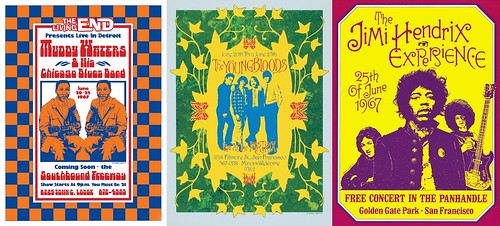
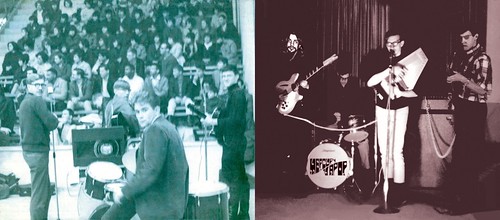
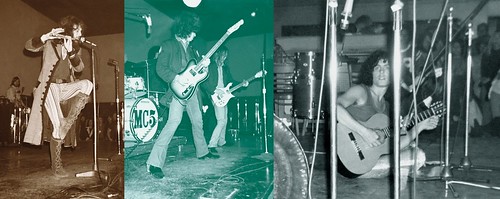
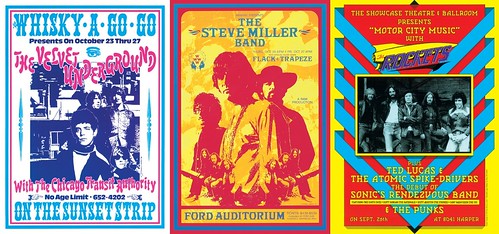


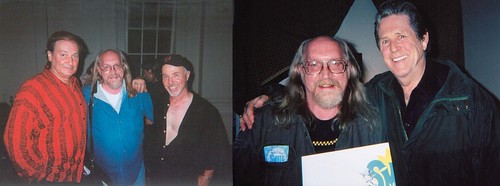
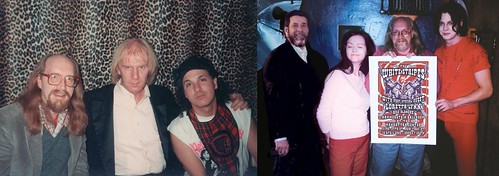

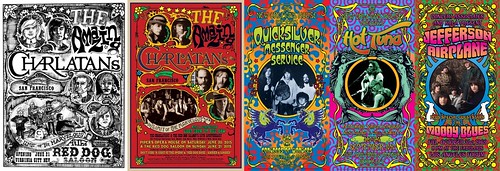

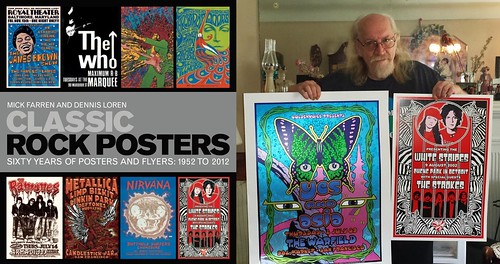
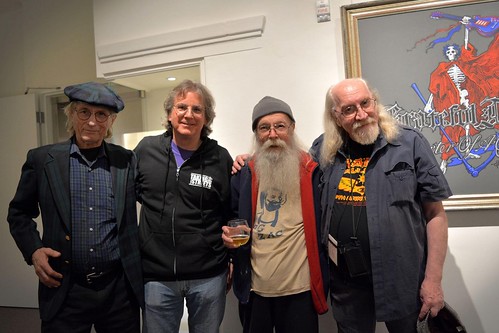
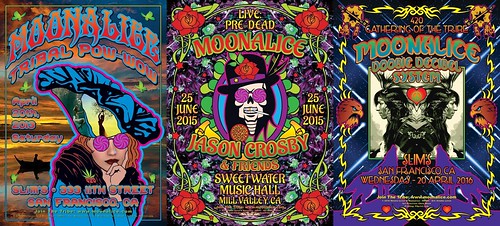
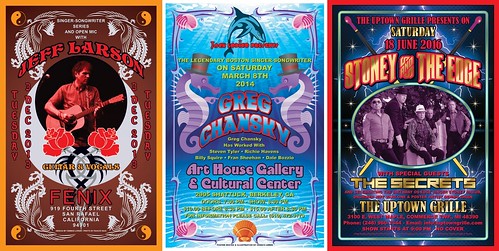
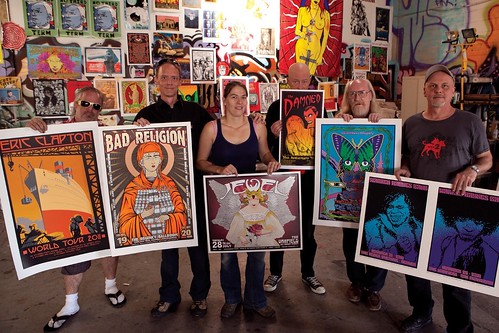
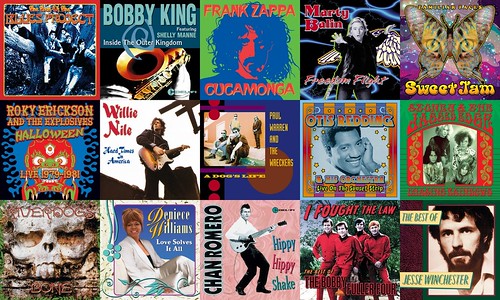
 Posteaza pe pagina mea de Twitter
Posteaza pe pagina mea de Twitter Posteaza pe pagina mea de Facebook
Posteaza pe pagina mea de Facebook Posteaza pe pagina mea de MySpace
Posteaza pe pagina mea de MySpace Trimite pe YM
Trimite pe YM Trimite pe email
Trimite pe email


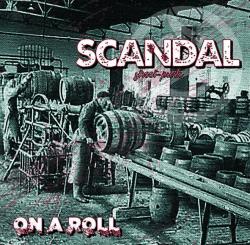
Comment on: Dennis Loren: Jimi Hendrix complemented me for the poster I had done (Part Two)